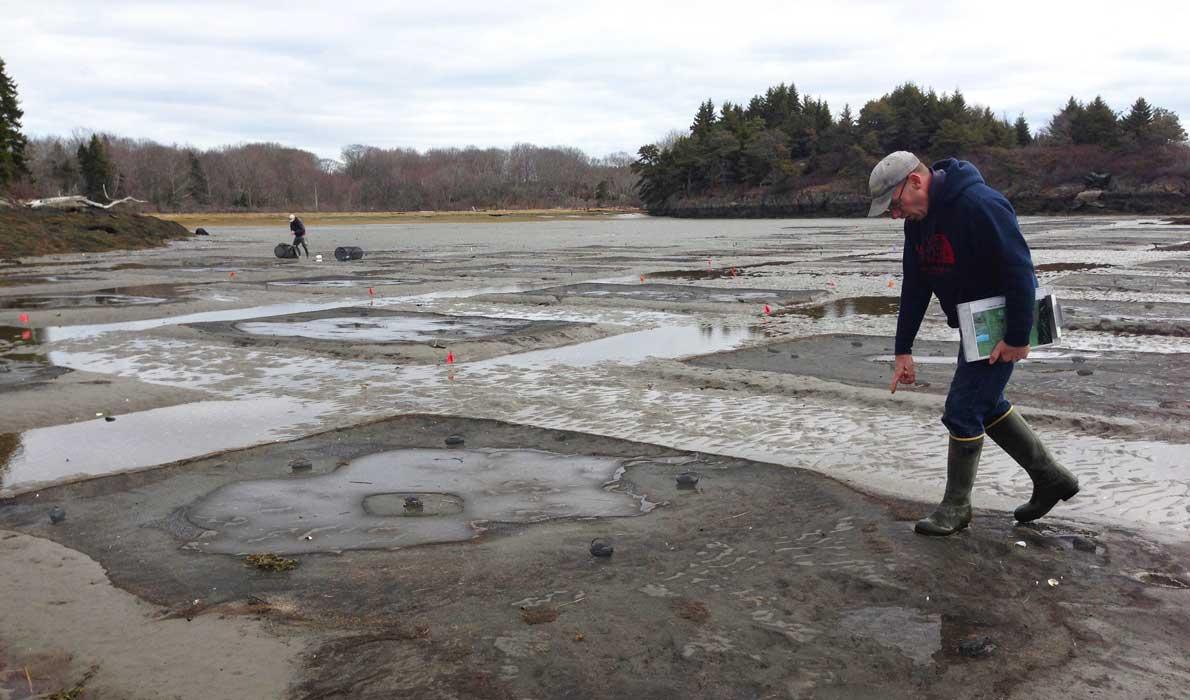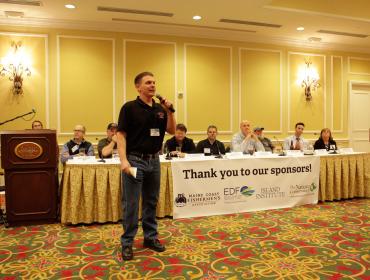Posted May 19, 2015
Last modified December 4, 2019
By Susie Arnold, Ph. D. and Heather Deese, Ph. D.
"We believe, yes!" This is Georgetown clammer Chris Warner's answer to the question: Can a single shellfish harvester with a small up-front investment create a viable soft-shell clam farm and beat the green crabs?
But you don't need to take his word for it. Just visit the Heal Eddy Clam Restoration Project in Georgetown. Under protective netting keeping the green crabs out, you can see evidence of clams everywhere. In an adjacent experimental plot, without a net, there are no clams.
Warner first started to notice the impact of green crabs about five years ago. Since that time, the story of green crabs decimating the soft-shell clam industry has been all over the news. Clammers are concerned there will be no fishery in a few years if nothing is done.
But Maine's soft-shell clam fishery need not go down the same path as the declining groundfish fishery and the closed shrimp fishery. We have a chance to do something different. The idea of farming clams is not new, but it can be controversial, in that leasing a section of the clam flat to an individual clam farmer infringes on the common open-range tradition of most fisheries. However, the idea is to only lease out unproductive flats, leaving productive flats open for any town-licensed harvester.
Clam farming has been demonstrated on Cape Cod and in Freeport, and it works. Connor O'Neil, a Colby College senior and Freeport native, has been battling green crabs on clam flats for years. O'Neil recently won first place at the Green Crab Mitigation Competition held at Colby with his proposal on developing municipal leasing of clam flats for clam aquaculture in order to save the industry from green crabs.
In December 2012, Warner received permission for a three-year conservation closure on a 2.3-acre section of unproductive clam flat to demonstrate the efficacy of farming clams with protective netting. For the first year and a half, he set up his own seeding project with nets. The clams he planted that first year are now "legal and beautiful," according to Warner, but still off limits to harvesting.
In 2014, Manomet, a non-profit based in Brunswick, teamed up with Warner to create the Heal Eddy Restoration Project. Manomet's interest is in restoring diversified fisheries throughout the Maine coast. The organization saw an opportunity to combine scientific expertise with Warner's extensive knowledge as a shellfish harvester, to try something practical and meaningful for the industry.
The project team includes Warner; John Hagan, president and chief scientist at Manomet; Brian Beal, a professor at UMaine Machias; and Jay Holt, the surrounding landowner of the clam flat.
There are 70 experimental plots, each 200-square-feet, with six different treatments, some with seeded clams and some without. They are testing netting with two different mesh sizes, and have control plots with seeded clams but no net, and others with no seeded clams and no nets.
The seeded plots have 4,200 to 4,300, 5-10 mm soft-shell clams purchased from the hatchery at the Downeast Institute in Beals. Setting up the entire experimental farm, with appropriate replication and controls, took three people to complete through just four low tides. Now, Warner spends about an hour a week monitoring and maintaining the farm.
The team estimated that prior to its closure, the unproductive flat contained only about 20 bushels of clams in total over the entire 2.3 acres. After two years, the clams under only three nets (600 square feet) will produce 20 bushels.
For context, on a good day, an experienced clammer can expect to dig 3-5 bushels a day when digging a productive flat. Warner anticipates that if he were allowed to harvest the clams under his experimental nets, he could dig two nets on one low tide, an equivalent to about 13 bushels.
What every digger wants to know is: How much money can be made, with how much effort? The start-up costs were about $10,000, about half for the nets, buoys, flags and other equipment that would last 6-7 years, and half for the seed clams ($21/thousand clams at 10 millimeters).
There are 50 seeded plots with nets, which equates to at least 325 bushels. Obviously, if you were farming a flat for profit, you would not have control treatments with no clams and no nets, and you could harvest your clams when the price was high. Because of the scarcity of clams, the price is expected to reach as high as $200/bushel this season.
You can do the math.
The key to success, says Warner, "is a single harvester, with fire in the belly, skin in the game and a sense of delayed reward." The other critical piece is regulation. Currently, Warner can't continue his work past December. When his conservation closure runs out, he will lose sole access to the farm and the clams that will reach harvestable size next year.
Warner's ultimate goal is to provide a future for kids in the community who want to make a living off the water.
"I have four children, and I can't have them be a part of this. I can't get this in their blood and then tell them they have to go away," he says. "There is no job for them out here. That's sad. I can't teach my kids what I do the best. We are water people, and I can't teach them that because I don't want it in their blood."
But Warner is ready to fight for that heritage.
"I don't want to see the devastation in the soft shell clam industry to the point it is gone," he says. "I hope that we as a group know enough to fight before it is gone—because it will be gone.
"It's much bigger than one person and a clam farm. This can make a sustainable fishery," with Maine jobs for Maine kids who have the ocean in their blood.
Dr. Heather Deese is an oceanographer and the Island Institute's vice-president for strategic development. Dr. Susie Arnold is an ecologist and marine scientist with the organization.


